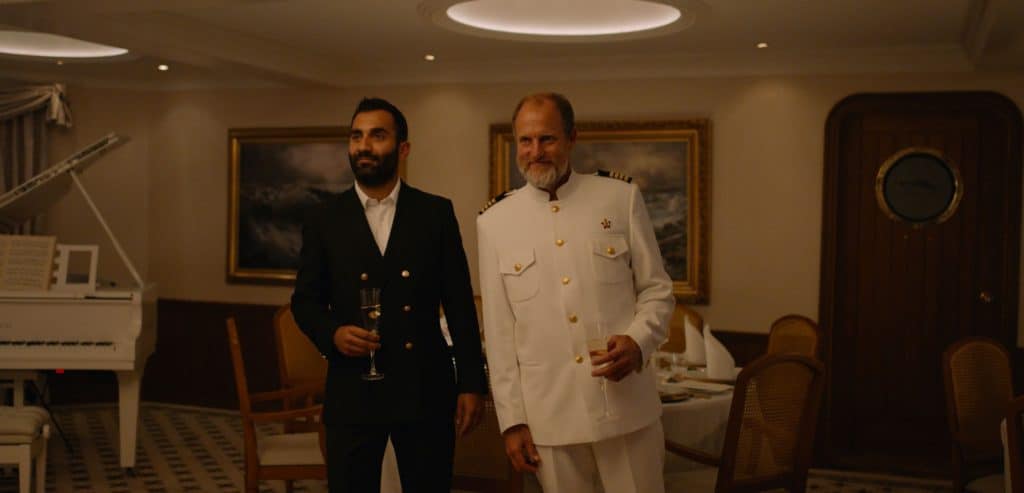Triangle of Sadness is Ruben Östlund’s sixth feature to date and, by far, his most expensive. It is also his weakest work thus far, and I will try to find out why with the help of some of his earlier films. It all begins in the model world, specifically the male one. We meet Carl (Harris Dickinson) and his colleagues going through some supposedly funny rituals concerning cheap and expensive clothes. The titular expression is explained when he goes through a mildly humiliating casting scene. The triangle refers to the lines of your face caused by excessive frowning. (maybe disapproval, as well?)
In a later scene between Carl and his partner Yaya at a restaurant, there is some mild awkwardness when the bill arrives, and both try to avoid paying in slightly elusive ways. She earns three times as much as he does, which she is not shy of pointing out. This is a quintessential Östlund scene that we’ve seen many times before. At its best, it creates a tension that creeps under the spectator’s skin and makes you feel uncomfortable. In his episodic second film, Involuntary (De Ofrivilliga 2008), there are several such moments. In one episode, a teacher feels (rightly or wrongly) that she is being ignored by her colleagues after an altercation between a teacher and a student.

In another chapter, two teenage girls pose for sexy pictures online, but do they know where to draw the line? In the most striking part, Leffe is a guy who loves to make pranks with his male friends but will have to endure a long, cumbersome conversation with his girlfriend about what took place at the beach and why. After an interesting short, Händelse vid bank (2010), he released Play in 2011. This work about immigrant teens robbing Swedish boys of their phones using a rather elaborate scheme turned out to be quite controversial. Based on actual events that were not seriously investigated, since the authorities were afraid of being labelled racist, the film created quite a stir upon release.
I recall watching it in Paris the week after the Quinzaine premiere, and a man next to me shouted that the film was sinister and racist. A subplot on a train attempts to approach the themes from other angles, and it depicts casual racism from Swedes as well. Whatever the merits are of those two films, they are worth seeking out if your first encounter with Östlund was Turist (Force Majeure, Snow Therapy 2014). There, you will find Östlund making the spectator uncomfortable instead of looking down on his characters and making the audience feel superior to them, morally and otherwise. A prime example of the latter is Radu Jude’s Berlinale winner from last year.

Triangle of Sadness continues on a luxury cruise where the captain is a Marxist (Woody Harrelson), and the passengers include the couple we met before and a Russian capitalist. The latter, who is in the fertilizer business, has no other function and might as well have been displayed as a bot spewing out talking points. “I sell shit” There is also Jorma (Swedish comedian Henrik Dorsin), who is quite timid but might have to step up at a later point. Once the film enters the cruise phase, the supposed satire is swept away by toilet humour in the most literal sense.
The Triangle of Sadness is jammed into a Square
The insanely wealthy passengers will become violently ill, which leads to scenes that are supposed to be gross but are primarily dull. They are also highly derivative, taking their cues from several seventies films like La grande bouffe (1973) or any of Makavejev’s films. Mr Creosote in The Meaning of Life (1983) is another obvious reference. Obvious is the operative word in Triangle of Sadness, where everything is spelled out repeatedly. The final act shows some passengers stranded on an island, and what might happen there? Could it be that the service staff who actually knows how to do practical stuff will be in charge? Lo and behold, that’s what happens.
Said staff is reduced to one character played by Dolly de Leon. We’ve seen her in numerous Lav Diaz films, and here, she plays a character who starts to boss people around. Here, there is an opportunity to depict how people are basically the same, but no. In general, the whole island sequence feels like a missed opportunity, and I would be surprised if anyone is blindsided by the final reveal. The production values are evident on the screen, even if the cinematography isn’t that interesting. This is not a bad film as much as a lazy and uninspired one. Östlund wrote the script, but the way the film looks, you feel like someone dumped it into his lap.

The most troubling aspect of the film has a meta element to it. As previously mentioned, Östlund used to make the viewer feel uncomfortable. Here, he rather resorts to a mob mentality, where the audience is supposed to look down on the characters and cheer when bad things happen to them. The same goes for the other competition film on Saturday, R.M.N by Mungiu. There is a particular irony about that when the film is playing in Cannes for a highly privileged audience, whether it’s the black-tie crowd in Lumière or the 3 Days in Cannes youngsters.
When you see people in Cannes yelling at service staff for not being let into a delayed screening and then mocking the passengers in Östlund’s film for their behaviour, even calling for a revolution, the perfect irony is reached. That would actually be the perfect meta-project: to juxtapose the crowd on the cruise with the accredited Cannes people cruising through the town, possibly attending a cocktail party after the screening. Maybe that was Östlund’s devious plan all along? In that case, I salute him.
Triangle of Sadness

Director: Ruben Östlund
Date Created: 2025-06-30 08:14
1
Pros
- None
Cons
- Superficial
- Trite
- Boring


Not a good film, pretentious arty remake of ‘the admiral chrichton’.